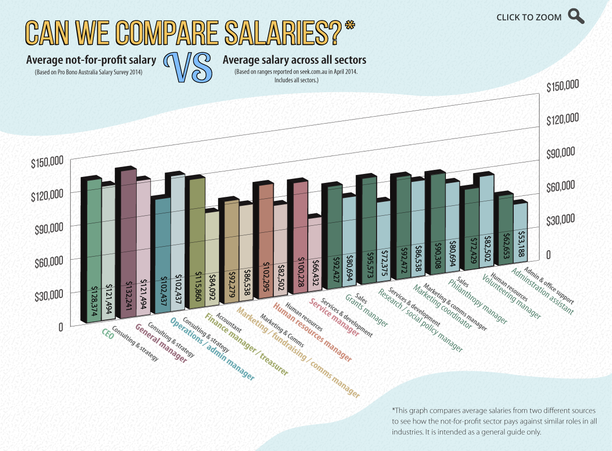Compare courses from top Australian unis, TAFEs and other training organisations.
Can’t Find That High Salary? You’re Looking in the Wrong Place
Think big profits mean large salaries? Think again. Think you can’t make a difference and put food on the table? Think again, again. A new survey reveals it seems you can do good and earn well.
Marni Williams
Jun 17, 2025
If you’re scouring job boards hoping to land a high-paying gig in a Fortune 500 company, you may be overlooking a sector hiding in plain sight: the not-for-profit world.
It’s a common misconception that high salaries only exist in the private sector. But updated industry insights show that many roles in Australia’s not-for-profit (NFP) sector offer competitive—and often above-average—remuneration. Add in meaningful work, potential tax perks, and job satisfaction, and the NFP pathway becomes more attractive than ever.
Yes, You Can Do Good and Earn Well
According to Pro Bono Australia, thousands of professionals working in the NFP space—especially in mental health, health care, and community services—are reporting six-figure incomes, with the added bonus of purpose-driven work.
The Australian Bureau of Statistics reported the average full-time adult salary in Australia sits at just under $98,000 (as of November 2024). Many NFP roles surpass this, particularly in senior leadership, health, disability, and education services.
And when you factor in FBT exemptions and salary packaging benefits—common in not-for-profits—you can often stretch your take-home pay even further.
Highest Paid Not-for-Profit Sectors
Based on Pro Bono Australia’s salary benchmarking data, the following sectors offer some of the most attractive average salaries in the NFP space:
- Mental Health – CEOs average over $200,000
- Health Care & Disability – Senior roles exceed $140,000
- Education – Executive salaries well above $120,000
- Animal Welfare & Youth Services – Competitive leadership pay
In these areas, even mid-level managers such as service managers, finance leads, or general managers regularly report earnings over $100,000.
Lowest Paid Not-for-Profit Sectors
Sectors such as arts, culture, and heritage remain lower on the salary scale, with CEO salaries averaging around $94,000. However, that’s still comparable—or better—than salaries in equivalent roles in the same sectors within private enterprise, according to the ABS.
What Qualifications Do You Need?
The NFP workforce is highly educated. Pro Bono’s survey showed:
- 43% of employees held a bachelor’s degree
- 25% held a master’s degree
That’s higher than the national average of Australians with a university qualification. If you’re thinking about switching sectors, community services, social work, and leadership and management courses can help you gain the right credentials and fast-track your career change.
Salary Trends in NFP Leadership Roles

Want to move into leadership? Here’s what the data shows for top-tier roles across not-for-profits:
CEO Salaries

Range: $105,000 – $200,000+
Top sectors: Mental health, healthcare, animal welfare
State with highest average: WA ($141,600+)
Bonuses: Rare (15% of roles); average 7% of total package
General Manager Salaries

Range: $80,000 – $170,000
Top sectors: Mental health, education, medical research
Key driver: Larger orgs (100+ staff) = higher pay
Finance Manager / Treasurer Salaries

Range: $100,000 – $175,000+
Top sectors: Healthcare, education, multidisciplinary services
State with lowest average: SA & NSW (~$100K)
Marketing / Fundraising / Communications Manager Salaries

Range: $75,000 – $150,000
Top sectors: Research, medical, human rights
Bonus rates: Low; avg. 7% when offered
HR and Services Manager Salaries

Range: $90,000 – $130,000
Top sectors: Healthcare, disability services, multidisciplinary
Growth factors: Budget size and number of employees
Factors That Influence Pay
Your salary in the NFP sector may vary based on:
- Organisation size: Bigger budgets = better pay
- Employee headcount: More staff often means more complex roles
- Location: WA often pays more than eastern states for similar roles
- Specialisation: Expertise in areas like mental health, finance, or governance boosts earning potential
How to Make the Shift (and Make an Impact)
It’s not just about the money. A career in the not-for-profit sector offers:
- Purpose: Make a tangible difference in people’s lives
- Work–life balance: Many NFPs offer flexibility and hybrid work
- Professional development: Upskilling is encouraged, often funded
If you’re ready to pivot into a more meaningful role without sacrificing salary, explore:
- Community services courses
- Social work and counselling training
- Leadership and NFP management qualifications
Rethinking What a High-Paying Career Looks Like
If you’ve been chasing prestige or paycheques in the corporate world, it might be time to reconsider where value—and values—intersect. The not-for-profit sector is proving that you don’t have to choose between meaningful work and financial security.
With salaries on par with or exceeding those in the private sector, plus the added benefits of purpose, flexibility, and tax advantages, not-for-profits offer a compelling career path for professionals across many disciplines.
So if you’re ready to do more than just make a living, why not make a difference too?
About the author
Marni Williams provides tips on career progression, job applications, and educational pathways at Career FAQs.
